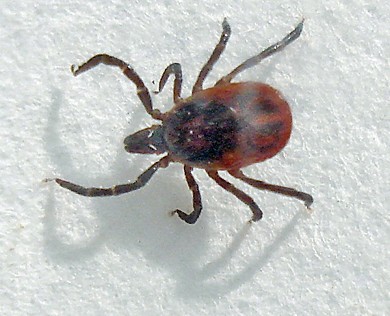
As high season for biting insects gets underway the MCofS has issued advice to hillgoers to make sure a Munro is the 'only tick they come home with'. These tiny blood suckers can carry Lyme disease, a condition that's often hard to spot, unfamiliar to many GPs, and potentially very serious if left untreated.
Heather Morning, Mountain Safety Advisor with the MCofS, advises people to check themselves carefully after a day on the hill to ensure they haven’t picked up any unwanted guests.
Ticks are small arthropods (related to spiders & scorpions), common in vegetated rural areas and especially where there's livestock or deer. They're keen on mild damp climates, which makes the British hills an ideal habitat. Aside from being a nuisance ticks carry diseases, including Lyme disease, which can be extremely serious if not diagnosed early.
Anecdotally they seem to be out in force this year. Perhaps it's a result of the mild winter? The Hilltalk forum is full of ticks today - see here.
Heather's had a brush with them too:
'Last weekend we enjoyed a camping trip over in Moidart in the most stunning weather' she said. 'Relaxing at the camp site after a day on the hill, we noticed several ticks on our feet and during the following week found several latched onto our bodies even though we had thoroughly checked ourselves when we got home. The dog didn’t escape either; we have been removing engorged ticks from her for several days now.'
She recommends that hill walkers are vigilant and take some simple precautions and make frequent thorough checks.
Here's more tick advice, originally posted on UKH a couple of years ago:
- Tuck your trousers into socks or boots and tuck shirts into trousers to minimise the chance of ticks getting to exposed skin.
- Wear gaiters
- Avoid shorts
- Wear light coloured clothing to make any attached ticks easier to spot.
- Check yourself and children every couple of hours for attached ticks.
- Apply insect repellent with 20%-30% DEET to any exposed skin.
- You can also apply Permethrin to clothing (do not apply directly to skin) which can be bought in camping or hunting shops.
- Avoid wooded areas with tall grass and try to stay in the centre of trails to avoid tree branches, leaves and long grass where ticks usually lie in wait for an unsuspecting victim to brush past. Don't stop and sit in thickly vegetated areas - bracken for instance.
- Once home check your entire body for ticks. Important areas to check are behind the ears, inside the outer ear, under the arms, behind knees, the trunk of the body and the scalp. Also the groin etc. where some hard to reach places may be best examined by a close friend.
- If you find any ticks remove them. For information on removing a tick safely see Safe Tick Removal courtesy of Tick Talk Ireland (the advice is good for ticks over here too of course).
Possible early signs of Lyme disease include a characteristic 'bull's eye' rash at the bitten area, and flu-like symptoms. If in doubt see a doctor, and be prepared to argue your case if they seem a little less than clued up on the condition (a common complaint).











Comments